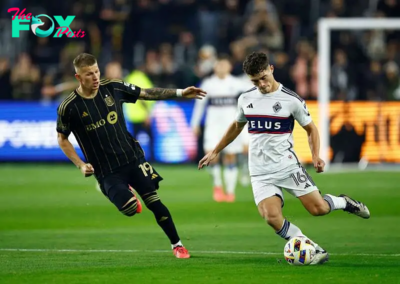Football
Passion of the Playoffs: “I’ve spent hundreds of hours making tifos this year”
For soccer fans in the United States and in Europe the word ‘tifo’ is a familiar one. It is used to describe the vast displays of flags and banners created by supporters to pay tribute to their player, their team or their city.
The name comes from the Italian word ‘tifosi’, which literally translates to ‘those infected with typhus’. It references the frenzied, irrational nature of soccer fandom in Italy, but it could be applied more specifically to those die-hard supporters willing to spend hundreds of hours to produce the stunning works of sporting art.
Ryan Bross is the President of Philadelphia Union supporters group Sons of Ben and takes an active role in the tifo creation process. Likewise Chris Zimmermann of St. Louis City Punks has spent hundreds of hours producing tifos in the club’s inaugural season.
As part of our ‘Passion of the Playoffs’ series we spoke to the fanatics behind those incredible matchday displays.
How are tifos designed?
Tifo is an element of European soccer culture that has exploded in the States in recent years, fuelled in part by a Healthy comPetition between supporters. Images of the biggest and the best are shared far and wide on social media and there is a growing community of fans dedicating themselves to the art form.
The whole process takes months from conception to deployment, but stage one is always the design. Tifo designs often feature elements from the current team and their home city, but may also reference past triumphs and long-standing rivalries. Beyond all else, they are a representation of the fans and their love for their team.
Tifos offer supporters a chance to issue a public statement; a message to their team, to the opposition and to soccer fans around the world. At St. Louis, Chris Zimmermann explains that the various supporter groups take turns to design the tifo, ensuring a diversity of ideas.
“I’m in a group called the Punks,” Chris explains. “We did the season-ending tifo against Seattle, but every group puts their own spin on it so it’s sort of an organic process. The tifos reflect the city.”
Sometimes the tifo designs are a little more pointed and reference previous meetings and simmering rivalries with a healthy dose of humour.
Philadelphia Union lost to LAFC in the 2022 MLS Cup, an agonising penalty shoot-out defeat in the showpiece final. When the Union and LAFC met again earlier this year Philadelphia tifo creator Ryan Bross knew exactly how to mark the occasion.
“The banner we used was one that I thought of in the stands at the MLS Cup final. [LAFC] had done a Dragon Ball z character, Gogeta, and immediately I thought, ‘When they play us at home we can do the same, with a character that’s stronger.’”
When their next meeting came Philadelphia supporters at Subaru Park unfurled a huge tifo featuring their own anime design, a playful nod to LAFC’s effort.
Hundreds of hours of work for tifo creators
The huge scale of MLS tifo displays has captured the imagination of soccer fans across the United States. But that desire to stand out now means thousands of hours of labour go into every single design, most of which are flown for just a few minutes.
“I’ve spent probably 300-400 hours of my life making tifo this year,” St. Louis fan Chris says.
“For the most part the artist comes up with the design digitally. Then we have this several thousand square-foot piece of fabric and we have to get the design onto the fabric.”
Fortunately, Chris studied theatre production in college and knows what it takes to turn intricate designs into building-sized works of art.
He explains that tifo production often centres around five people, the hardcore, who each put in north of 70 hours on every design. Then there could be another 15-20 needed for late night craft sessions as the intricate design is agonisingly copied and cut into huge swathes of fabric, often in freezing warehouses or windy car parks.
The final stage, the paint, is typically an open affair with supporters encouraged to come down to participate in the project. Chris estimates that a total of around a hundred people are involved in the production of each tifo.
It’s a major project, and one that often brings logistical headaches for those involved. Ryan recalls a rushed effort to get the Dragon Ball Z tifo ready in time for the Philadelphia game.
The two sides were scheduled in meet in the MLS in September, but as both advanced through the Concacaf Champions League it looked increasingly likely that their first game would come much sooner. But Ryan, not wanting to jinx his team’s chances, refused to start work on the design until the semi-final fixture was confirmed.
They managed to get the tifo completed in record time after a frantic late effort, not aided by the less-than favourable Philadelphia climate.
He recalls: “I was trying to paint it leading up to a game against Toronto when it was nice and sunny. Then, within an hour, we were under a tornado watch.”
Why do supporters make tifo?
Members of the tifosi, as the word’s original meaning suggests, are not always rational in their support of their teams. The notion of spending hundreds of hours making banners may not be everyone’s idea of a hobby. But they fulfil an important role on matchdays.
At Philadelphia’s Subaru Park the tifo is flown from the raucous Sons of Ben supporter section, helping to create the famous in-stadium atmosphere.
Ryan says: “The players have to walk under our section to get out on the field. The seats there are metal so it’s very loud as you come out, smoke fills that whole area.”
“It’s very overwhelming sensory wise. I’ve heard from players on both sides, it’s very intense.”
The primary target of the tifo is those in attendance; the players on the field and the fans in the stands. But for supporters in the US the tifo is also a chance to bring the game to a wider audience, with the most impressive designs shared far and wide on social media.
Chris explains: “In most places soccer is the number one sport so it needs no introduction. Here you’re fighting with baseball, hockey, basketball and football; it’s something that sets us apart from those other sports.”
“It’s a nice shorthand for ‘We aren’t football, we aren’t baseball. We do this.’”
With the MLS Cup Playoffs heating up expect to see plenty more tifo being unfurled in stadiums across the country. But spare a thought for the hardy souls spending their November evenings working tirelessly to spread the message, the tifosi behind that wall of colour.
-

 Football3h ago
Football3h agoHurting Luis Palma Makes Celtic Vow After Honduras Collapse
-

 Football3h ago
Football3h agoEuro 2024 ‘Keeper “Sad” After Celtic Move Didn’t Materialise
-

 Football3h ago
Football3h agoMo Salah already back at the AXA with glimpse at Alisson recovery work
-

 Football3h ago
Football3h ago‘Always the plan’ – Why goalkeeper is already back at Liverpool after loan ended
-

 Football8h ago
Football8h ago‘That’s what you play for’ – Nicolas Kuhn Responds to Germany Call-up Suggestions
-

 Football8h ago
Football8h agoLuis Palma Given EAFC 25 Recognition for Honduras Form
-

 Football8h ago
Football8h agoConor Bradley scores and earns Man of the Match ahead of likely Liverpool start
-

 Football8h ago
Football8h agoVirgil van Dijk left Dutch squad with ‘minor complaints’, trained separately – Koeman





















